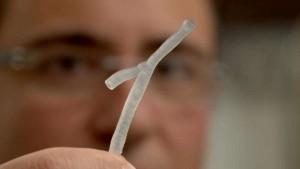 A clogged artery is bad news. Plaque in the major blood vessels carrying blood away from the heart can lead to heart attack or stroke – but only certain types of plaque. According to Associate Professor Peter Barlis of the University of Melbourne, identifying the specific kinds of plaque that cause heart attacks is key to preventing them, and 3D modeling and printing may lead to doctors being better able to locate and identify those plaques.
A clogged artery is bad news. Plaque in the major blood vessels carrying blood away from the heart can lead to heart attack or stroke – but only certain types of plaque. According to Associate Professor Peter Barlis of the University of Melbourne, identifying the specific kinds of plaque that cause heart attacks is key to preventing them, and 3D modeling and printing may lead to doctors being better able to locate and identify those plaques.
Dr. Barlis, who also works as a cardiologist at St. Vincent’s and Northern Hospitals in Melbourne, introduced a technique called optical coherence tomography (OCT) to Australia back in 2009. The technique involves using an ultra-high resolution camera to scan interior tissue, for example, the insides of the arteries in the heart. Dr. Barlis has been refining the technique specifically for cardiac patients, and he hopes that 3D modeling and printing will help fill some of the gaps that OCT still has.
”Using…optical coherence tomography (OCT), to scan the insides of the heart arteries has made it easier to image cholesterol plaques, but it still isn’t clear which of these plaques will go on to cause heart attacks,” he said. ”If we can identify these high-risk plaques more accurately and much earlier, we may be able to prevent heart attacks before they occur.”
 Heart attacks occur when plaque ruptures and forms a blood clot, but doctors currently don’t have a good way to identify which plaque buildup is at risk of rupturing. According to Dr. Barlis, 3D modeling could help cardiologists to predict where vulnerable plaque is likely to form – consequently helping them predict heart attacks, as Dr. Barlis and fellow researchers discuss in a recently published study.
Heart attacks occur when plaque ruptures and forms a blood clot, but doctors currently don’t have a good way to identify which plaque buildup is at risk of rupturing. According to Dr. Barlis, 3D modeling could help cardiologists to predict where vulnerable plaque is likely to form – consequently helping them predict heart attacks, as Dr. Barlis and fellow researchers discuss in a recently published study.
The University of Melbourne team is using cameras thinner than a human hair to obtain high resolution images of patients’ arteries. Those images are transferred to a supercomputer which converts them into 3D models, which are then 3D printed. The printed models allow cardiologists to closely study the structure of the artery and the behavior of blood flow within it. It also helps them to identify trouble spots where dangerous plaque is more likely to form.
”No two arteries are shaped the same. We’re all different, with arteries that have different branches and sizes, tapering from larger to smaller,” said Dr. Barlis. “And much like debris accumulates along a riverbank, plaque can cling to certain areas of a person’s artery. So this technology really gives us a clearer picture of those areas. We ideally want to use models to predict the best type of stent for a patient. Once this process is streamlined, we can have a patient on the table and an artery 3D printed and modeled to guide the procedure.”
You wouldn’t necessarily think of a heart stent — a tiny mesh tube placed inside an artery to keep the passage open — as something that can be customized. Doctors are using 3D printing and scanning to create tailored implants for other, much larger, parts of the body, but it almost seems impossible to design an implant customized to the unique anatomy of something as small as a blood vessel. It is possible, and it could significantly reduce the risk of stent collapse or other complications. Dr. Barlis and his team are working with the University of Melbourne’s School of Engineering to develop a biocompatible polymer for 3D printing customized stents, thanks to a grant from the Australian Research Council.
Not only that, but the team is also looking into developing a polymer capable of creating a stent that will gradually disintegrate inside the body, delivering drugs straight to the plaque’s location. Imperial College London and Harvard University are also collaborating on the research. Considering that heart disease kills millions of people every year, this potentially lifesaving technology can’t come soon enough. Discuss this new technology in the 3D Printed Arteries forum over at 3DPB.com.
Subscribe to Our Email Newsletter
Stay up-to-date on all the latest news from the 3D printing industry and receive information and offers from third party vendors.
You May Also Like
Gorilla Sports GE’s First 3D Printed Titanium Cast
How do you help a gorilla with a broken arm? Sounds like the start of a bad joke a zookeeper might tell, but it’s an actual dilemma recently faced by...
Nylon 3D Printed Parts Made More Functional with Coatings & Colors
Parts 3D printed from polyamide (PA, Nylon) 12 using powder bed fusion (PBF) are a mainstay in the additive manufacturing (AM) industry. While post-finishing processes have improved the porosity of...
$25M to Back Sintavia’s Largest Expansion of Metal 3D Printing Capacity Since 2019
Sintavia, the digital manufacturing company specializing in mission-critical parts for strategic sectors, announced a $25 million investment to increase its production capacity, the largest expansion to its operations since 2019....
Velo3D Initiates Public Offering in a Bid to Strengthen Financial Foundations and Drive Future Growth
Velo3D (NYSE: VLD) has been among a number of publicly traded 3D printing firms that have attempted to weather the current macroeconomic climate. After posting a challenging financial report for 2023,...
































